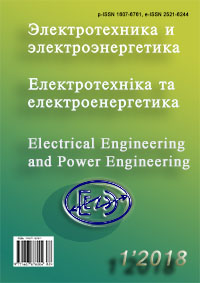PROTECTION OF 35 KV OVERHEAD TRANSMISSION LINE FROM THE INDUCED LIGHTNING OVERVOLTAGE
DOI:
https://doi.org/10.15588/1607-6761-2018-1-9Keywords:
nonlinear overvoltage limiters, storm surges, lightning protection, induced voltage, lightning impulse currentAbstract
Purpose. Develop recommendations for determining the optimal places for the installation of nonlinear overvoltage limiters for the protection of overhead transmission lines from the influence of lightning overvoltage on the basis of the model of the electric network 35 kV and to conduct research of the distribution of induced overvoltage in time along the route of the transmission line.
Methodology. The basis of the work is the simulation mathematical modeling of the processes of the occurrence of lightning overvoltage in the overhead transmission line 35 kV. For processing the research result, modern application software such as MathCAD, the environment of the SimPowerSystems software package MATLAB, was used.
Findings. In the course of the work, optimal distances, through which nonlinear overvoltage limiters should be installed to ensure the protection of electric network 35 kV from the induced lightning overvoltage, were obtained. As the result of the comparison of the two variants of the location of the nonlinear overvoltage limiters on the transmission line, namely every 2 km and on two towers located at a distance of 2 km from the beginning and 2 km from the end of the line, it was determined that the optimal option is to set overvoltage limiters every 2 km along the entire route of the overhead transmission line.
Originality. Simulation mathematical modeling of various variants of placement of nonlinear overvoltage limiters along the route of overhead transmission line 35 kV was carried out by the authors. The most optimal places of their installation was determined.
Practical value. The results of the work can be used in designing new or reconstruction of existing overhead transmission lines 35 kV, which will allow them to be protected from lightning overvoltage and reduce the number of emergency shutdowns.
References
[1] Bazeljan, Je.M., Rajzer, Ju.P. (2001). Fizika molnii i molniezashhity. Moscow, Fizmatlit, 320.
[2] Tihodeev, N.N. (1999). RD 153-34.3-35.125-99. Rukovodstvo po zashhite jelektricheskih setej 6-1150 kV ot grozovyh i vnutrennih perensprjazhenij, 2-e izd. Sankt-Peterburg, PJeIPK Mintopjenergo RF, 355.
[3] Wang Lei, Lin Fuchang, Yan Fei. (2006). Calculation and analysis of induced overvoltage on a transmission line caused by lightning strike to the tower. Power System Technology, 30, 271-274.
[4] GND 34.20.177-2004. (2004). Vymogy do proektuvannja povitrjanyh linij elektroperedachi naprugoju 6-35 kV z provodamy iz zahysnym pokryttjam, zatverdzhenyj nakazom Minpalyvenergo Ukrainy vid 02.03.2004 №130. [Requirements for the design of 6-35 kV overhead transmission lines with wires with a protective coating, approved by the order of the mineral fuel supplies of Ukraine from 02.03.2004 №130]. Kyiv, Ministry of Energy and Coal Industry of Ukraine, 24.
[5] Ping Liu, Xiao Yi, Xu Wang, Yongling Lu, Jianhui Yu, Wenjun Zhou. (2011). Calculation on Induced Overvoltage on Low-voltage Overhead Lines. IEEE Power Engin and Autom. Conf. (PEAM), 2, 68-72.
[6] Demailly B., Maciela F., Tartier S. (2002). Installation of composite surge arresters on transmission line. CIGRE Session, 33, 203-209.
[7] Tikhovod, S. (2007). Improvement of numerical methods of calculation of electromagnetic processes in complex nonlinear electric and magnetic chains. Electrical Engineering And Power Engineering, 1, 56-60.
[8] Kyryk V.V., Abdulaiev S.A. (2016). Vyznachennja optymalnogo miscja vstanovlennja OPN [Determination of the optimum location of the nonlinear overvoltage limiters]. Mizhnarodnyj naukovo-tehnichnyj zhurnal molodyh vchenyh, aspirantiv i studentiv "Suchasni problem elektroenergotehniky ta avtomatyky", 104-106.
[9] Bazutkin V.V., Kadomskaja K.P., Kostenko M.V., Mihajlov Ju.A. (1995). Perenaprjazhenie v jelektricheskih sistemah i zashhita ot nih: Uchebnik dlja vuzov. Sankt-Peterburg, Jenergoatomizdat, SanktPeterburgskoe otd-nie, 320.
[10] Zaluzhnyi, M. (2009). Simulation of non-stationary electromagnetic processes in the system of electrical supply of energoemic electrotechnological complexes. Electrical Engineering And Power Engineering, 2, 70-73.
[11] Mcdermott T.E., Short T.A., Anderson J.G. (1994). Lightning protection of distribution lines. IEEE Transactions on Power Delivery, 1, 9, 138-146.
[12] Vynokurova Je.V., Vorona S.S., Kyryk V.V., Dremov V.V. (2014). Ocinka navedenoi naprugy na linii elektroperedavannja naprugoju 10 kV [Assessment of the induced voltage on the transmission line 10 kV]. Gidroenergetyka Ukrainy, 4, 42-43.
[13] Fajbisovich D.L. (2012). Spravochnik po proektirovaniju jelektricheskih setej, 4-e izd., pererab. i dop. Moscow, JeNAS, 376.
[14] Razevig D.V. (1976). Tehnika vysokih naprjazhenij: Uchebnik dlja studentov jelektrotehnicheskih i jelektrojenergeticheskih specialnostej vuzov, izd. 2-e, pererab. i dop. Moscow, Jenergija, 488.
[15] Kadomskaja K.P., Rejherdt A.A. (2002). Vlijanie sposoba modelirovanija OPN i volny toka molnii na jenergeticheskie harakteristiki zashhitnyh apparatov, ustanovlennyh na oporah VL [Influence of the method of simulation of nonlinear overvoltage limiters and lightning current waves on the energy characteristics of rotective apparatuses installed on the towers of overhead transmission lines]. Jelektromehanika i Jelektrojenergetika: Nauchnyj vestnik NGTU, 1, 91- 100.
[16] Kadomskaja K.P., Lavrov Ju.A., Rejherdt A.A. (2004). Perenaprjazhenija v jelektricheskih setjah razlichnogo naznachenija i zashhita ot nih: Uchebnik. Novosibirsk, izd-vo NGTU, 320.
[17] Halilov F.H., Evdokunin G.A., Poljakov V.S. (2002). Zashhita setej 6-35 kV ot perenaprjazhenij. SanktPeterburg, 260.
Downloads
Published
How to Cite
Issue
Section
License
Copyright (c) 2018 KYRYK V. V., ABDULAIEV S. A.

This work is licensed under a Creative Commons Attribution 4.0 International License.
Creative Commons Licensing Notifications in the Copyright Notices
Authors who publish with this journal agree to the following terms:
Authors retain copyright and grant the journal right of first publication with the work simultaneously licensed under aCreative Commons Attribution License that allows others to share the work with an acknowledgement of the work's authorship and initial publication in this journal.
Authors are able to enter into separate, additional contractual arrangements for the non-exclusive distribution of the journal's published version of the work (e.g., post it to an institutional repository or publish it in a book), with an acknowledgement of its initial publication in this journal.
Authors are permitted and encouraged to post their work online (e.g., in institutional repositories or on their website) prior to and during the submission process, as it can lead to productive exchanges, as well as earlier and greater citation of published work.

